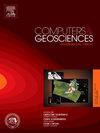Geothermal modeling in complex geological systems with ComPASS
IF 4.2
2区 地球科学
Q1 COMPUTER SCIENCE, INTERDISCIPLINARY APPLICATIONS
引用次数: 0
Abstract
In deep geothermal reservoirs, faults and fractures play a major role, serving as regulators of fluid flow and heat transfer while also providing feed zones for production wells. To accurately model the operation of geothermal fields, it is necessary to explicitly consider objects of varying spatial scales, from the reservoir scale itself, to that of faults and fractures, down to the scale of the injection and production wells.
Our main objective in developing the ComPASS geothermal flow simulator, was to take into account all of these geometric constraints in a flow and heat transfer numerical model using generic unstructured meshes. In its current state, the code provides a parallel implementation of a spatio-temporal discretization of the non-linear equations driving compositional multi-phase thermal flows in porous fractured media on unstructured meshes. It allows an explicit discretization of faults and fractures as 2D hybrid objects, embedded in a 3D matrix. Similarly, wells are modeled as one dimensional graphs discretized by edges of the 3D mesh which allows arbitrary multi-branch wells. The resulting approach is particularly flexible and robust in terms of modeling.
Its practical interest is demonstrated by two case studies in high-energy geothermal contexts.
利用 ComPASS 进行复杂地质系统的地热建模
在深层地热储层中,断层和裂缝发挥着重要作用,它们是流体流动和热传递的调节器,同时也是生产井的进料区。为了准确模拟地热田的运行,有必要明确考虑不同空间尺度的对象,从储层本身的尺度到断层和裂缝的尺度,再到注水井和生产井的尺度。我们开发 ComPASS 地热流模拟器的主要目的是在使用通用非结构网格的流动和传热数值模型中考虑所有这些几何约束。在目前的状态下,该代码提供了非结构网格上多孔断裂介质中驱动成分多相热流的非线性方程时空离散的并行执行。它允许将断层和裂缝明确离散化为嵌入三维矩阵的二维混合对象。同样,油井被建模为由三维网格边缘离散化的一维图形,允许任意多分支油井。在高能地热领域的两个案例研究证明了这种方法的实用性。
本文章由计算机程序翻译,如有差异,请以英文原文为准。
求助全文
约1分钟内获得全文
求助全文
来源期刊

Computers & Geosciences
地学-地球科学综合
CiteScore
9.30
自引率
6.80%
发文量
164
审稿时长
3.4 months
期刊介绍:
Computers & Geosciences publishes high impact, original research at the interface between Computer Sciences and Geosciences. Publications should apply modern computer science paradigms, whether computational or informatics-based, to address problems in the geosciences.
 求助内容:
求助内容: 应助结果提醒方式:
应助结果提醒方式:


